Author: @charlotte0211z, Metrics Ventures
1 Jupiter: Leveraged Targeting of Solana Ecosystem
1.1 Will Solana Become the "Ethereum Killer"?
Solana is regaining momentum from the FTX scandal and has become a leader in the cryptocurrency market after experiencing a surge in the fourth quarter of 2023. In 2024, it continued to ignite market sentiment with a high multiple increase in ecosystem airdrops and MEME tokens, positioning itself as the top contender to become the "Ethereum Killer." We review the growth of the Solana ecosystem from the perspectives of data, market sentiment, and ecosystem prosperity, and explain why the importance of positioning in the Solana ecosystem should be significantly elevated in this cycle.
Various data related to Solana are rapidly surging. Solana's TVL began to grow rapidly in the fourth quarter of 2023, increasing from approximately $500 million on October 1, 2023, to nearly $8 billion recently, representing a 1500% increase over two quarters and approaching the peak of $12 billion in November 2021. DEX trading volume, influenced by MEME tokens, is rapidly increasing, with a record-breaking volume of over $3.8 billion on March 16, and the proportion of DEX trading volume is rapidly growing, approaching that of Ethereum and even surpassing it in the short term. In terms of token performance, Solana's token price began to surge in October 2023 and is approaching a peak of $250, with a total market value surpassing the peak of the previous bull market.
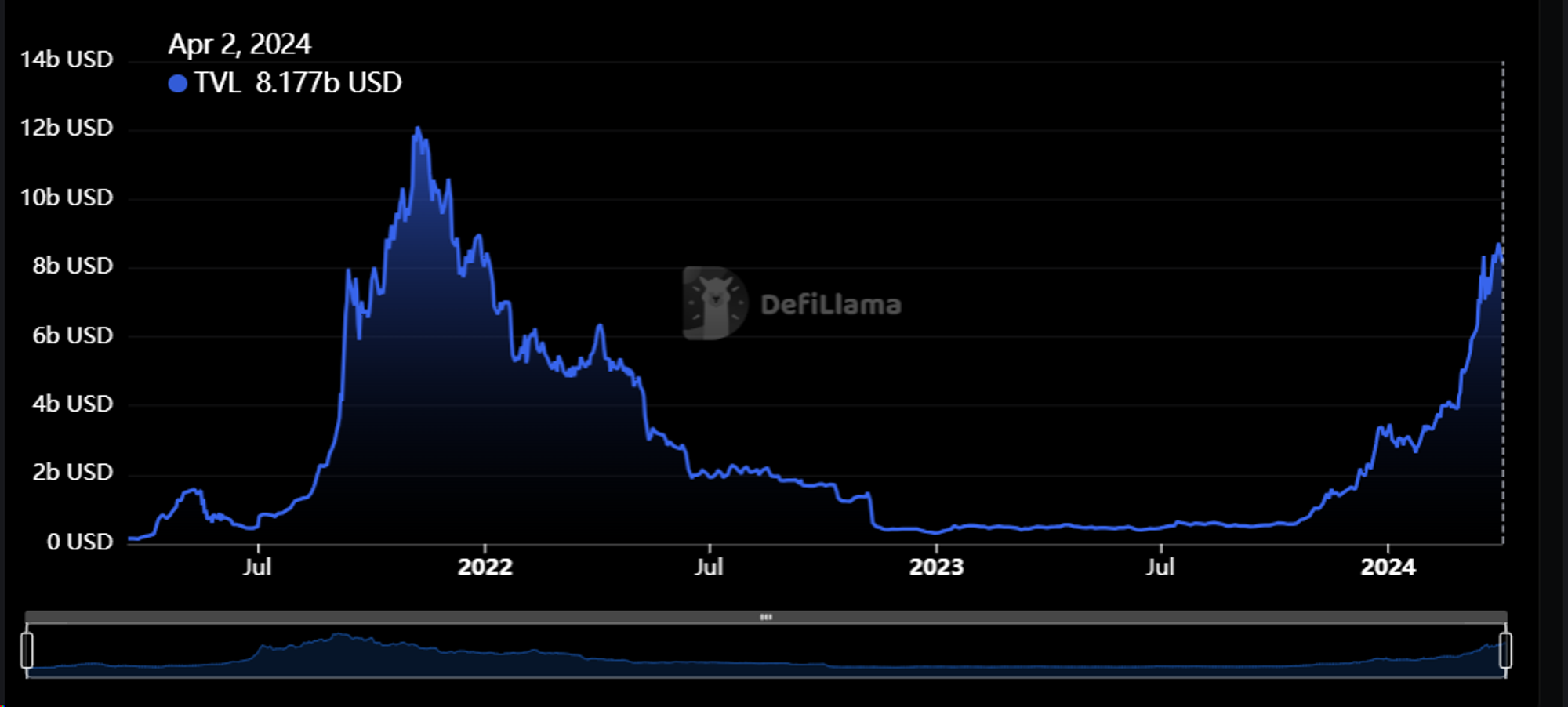
(Solana TVL over time chart, source: DeFiLlama)
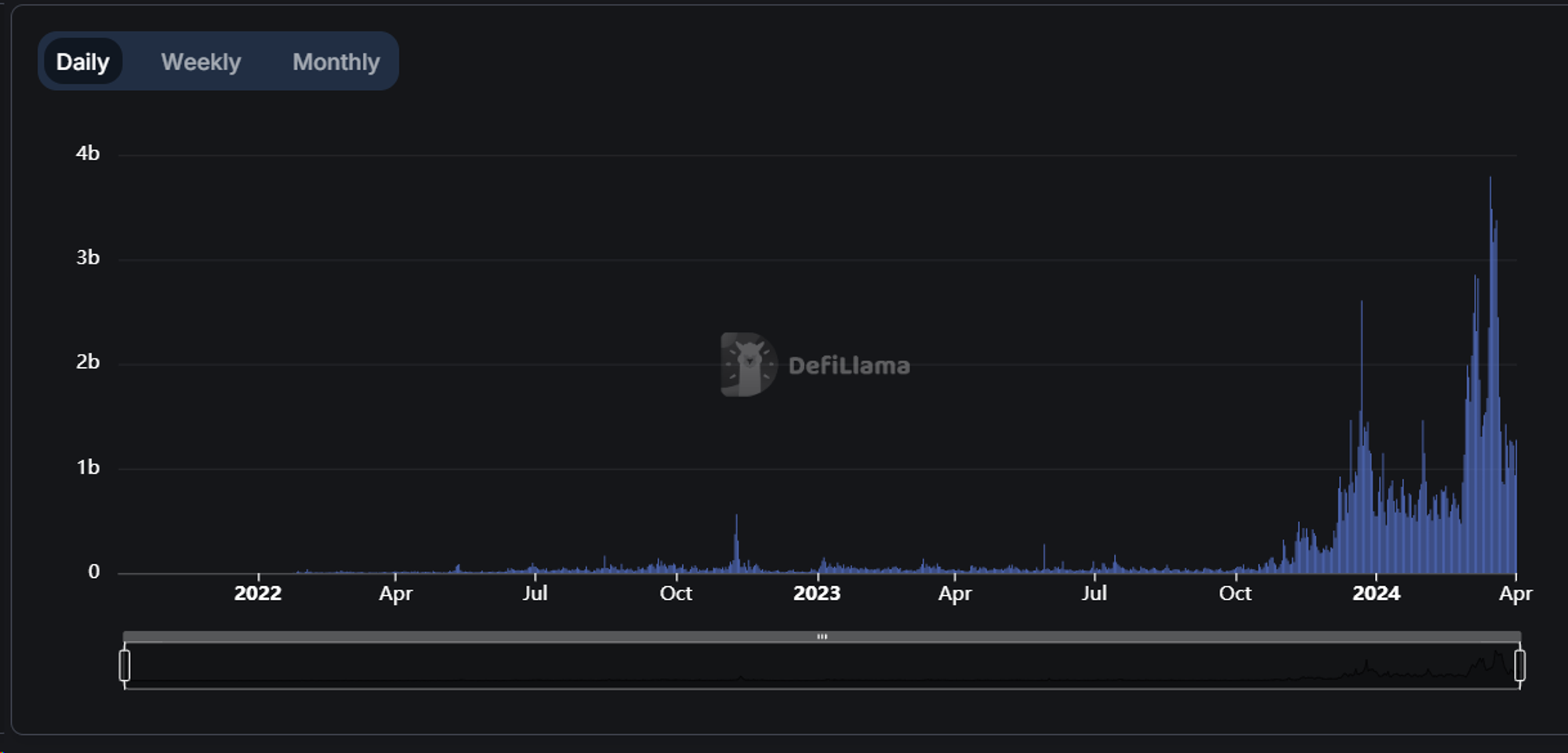
(Solana DEX trading volume over time chart, source: DeFiLlama)
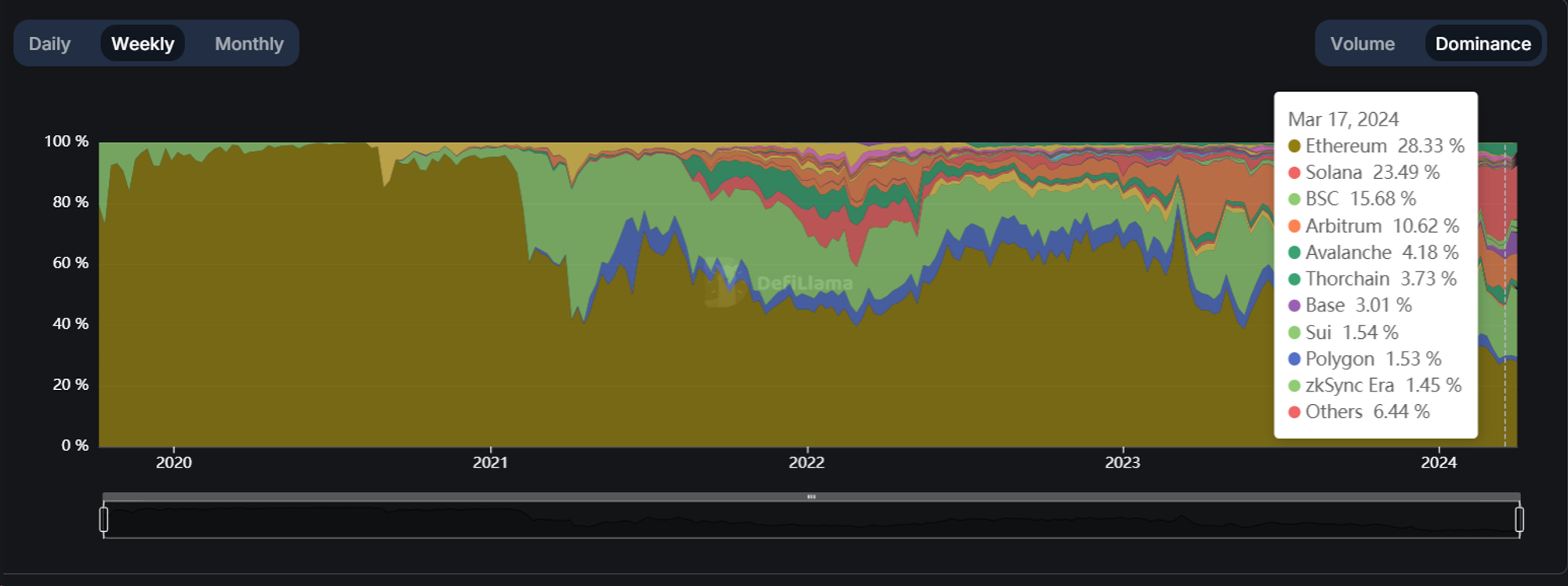
(DEX Volume Dominance of various public chains over time chart, source: DeFiLlama)
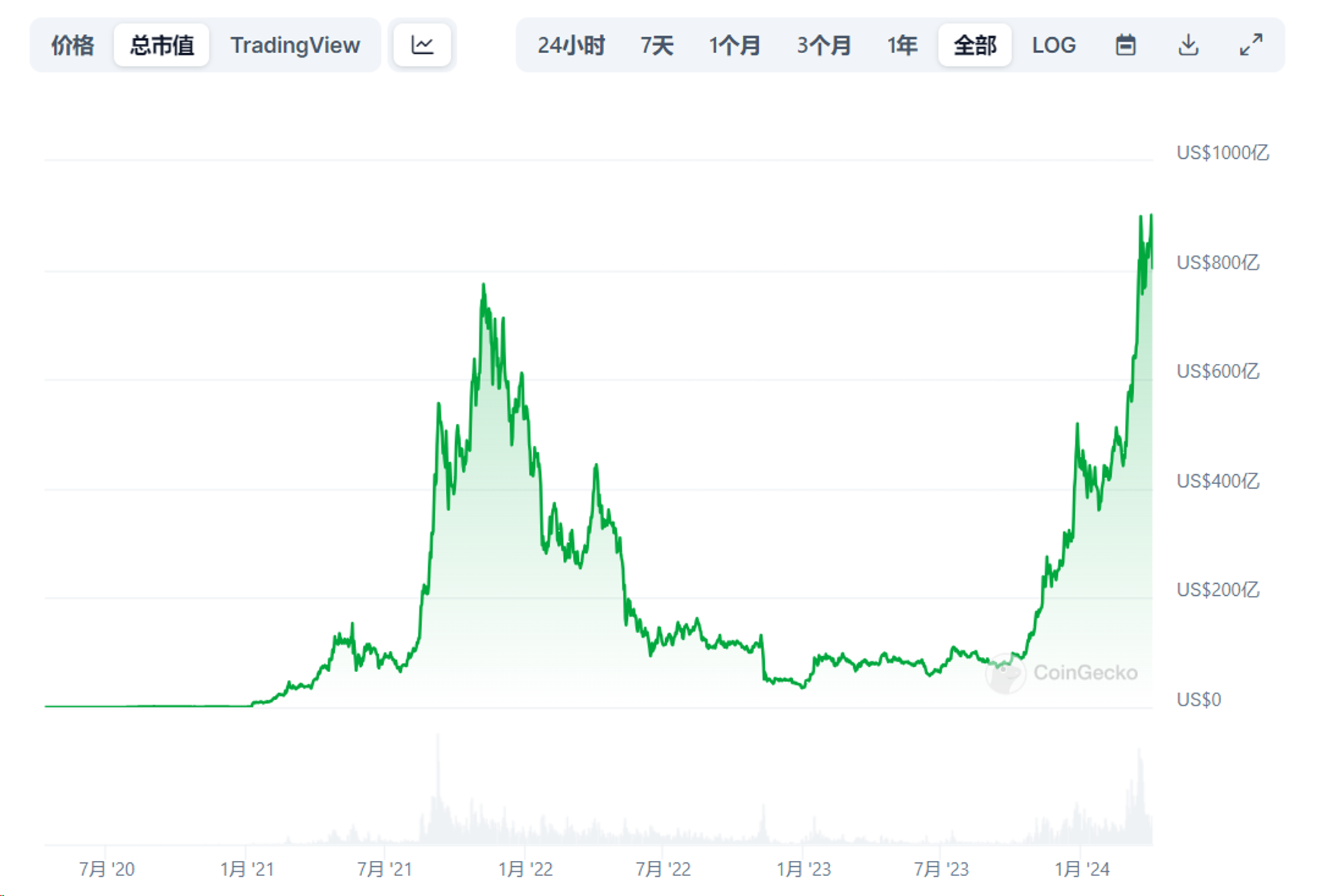
(Solana total market value over time chart, source: Coingecko)
From other perspectives such as ecosystem and market sentiment, the reasons why the Solana ecosystem is rapidly growing and still has significant upside potential include the following:
- Solana has overcome the negative impact of the FTX incident: With the conclusion of SBF's trial, the FTX scandal has basically come to an end. From the perspective of the Solana ecosystem, Solana has gradually emerged from the trough of the FTX incident. Regardless of ecosystem development, investor sentiment, or market sentiment, the negative impact of the FTX incident on Solana has disappeared. According to The Block, citing informed sources, the 41 million SOL locked by FTX has attracted multiple buyers, and there is a high demand in the market for acquiring SOL tokens. Both from a financial perspective and institutional sentiment, this has provided positive indicators for the future growth expectations of Solana.
- Solana has become the main base for DePIN projects, with multiple ecosystem projects about to launch tokens: With its low cost and high performance, Solana has become the main ecosystem for hosting DePIN narratives. In addition to leading DePIN projects such as Helium, Shadow, and Hivemapper, a number of AI×DePIN projects have also chosen the Solana ecosystem, including io.net, Render, Grass, and Nosana. At the same time, several projects in the Solana ecosystem have yet to launch tokens, such as io.net, Magic Eden, etc., with reference to JUP and JTO. These token launches and airdrops will continue to inject vitality into the Solana ecosystem.
- Solana has achieved product-market fit and may become the main interaction ecosystem for retail investors and new users in this cycle: Solana's high performance and extremely low transaction costs make it extremely suitable for retail trading and reduce the barrier to entry for new users. The transaction fees on Ethereum L1 can reach several tens or even hundreds of dollars during peak periods, and this number is rising with the increase in ETH price, while L2 liquidity is dispersed and increases the difficulty for new users to operate. In addition, the concept of Fair Launch has been well received by retail investors in this cycle. Retail investors generally believe that Ethereum has become the main base for VC projects, while the strong support for MEME coins in the Solana ecosystem has driven market sentiment from the bottom up. Simple operations, low-priced chips, and wealth creation effects will be the main drivers attracting new retail investors.
In summary, from the perspectives of data performance, ecosystem prosperity, and market sentiment, the Solana ecosystem has demonstrated strong capabilities in the recent period and has shown the ability to sustain growth and a logical path of growth in the bull market. Regardless of whether Solana is the "Ethereum Killer," from an allocation perspective, the Solana ecosystem is worth the same level of attention as the Ethereum ecosystem, and in terms of growth potential, it may even be more aggressive.
1.2 Jupiter will resonate in sync with Solana
As a liquidity infrastructure on the Solana ecosystem, Jupiter will resonate in sync with Solana.
Firstly, on the Solana network, Jupiter guides approximately 50%-60% of the trading volume and over 80% of organic trading volume (excluding trading bots). This means that the majority of traders participating in the Solana ecosystem, apart from using trading bots, need to interact with Jupiter's front end to complete the vast majority of their trades. With its position as a trading infrastructure and a large customer capture scale, Jupiter has become one of the most important protocols in the Solana ecosystem. In addition, as a DEX aggregator, its importance to the Solana ecosystem is actually far greater than that of 1inch to Ethereum, because Solana is naturally more suitable for liquidity aggregators. Splitting a transaction into multiple parts will generate high gas fees, which creates significant friction for Ethereum, where gas fees are already high, while the cost to users on Solana remains low. Therefore, in terms of trading volume, Jupiter is basically equivalent to Uniswap, and even surpasses it in the short term, both of which are far higher than other trading infrastructures. It can be said that Jupiter is the Uniswap of the Solana ecosystem.
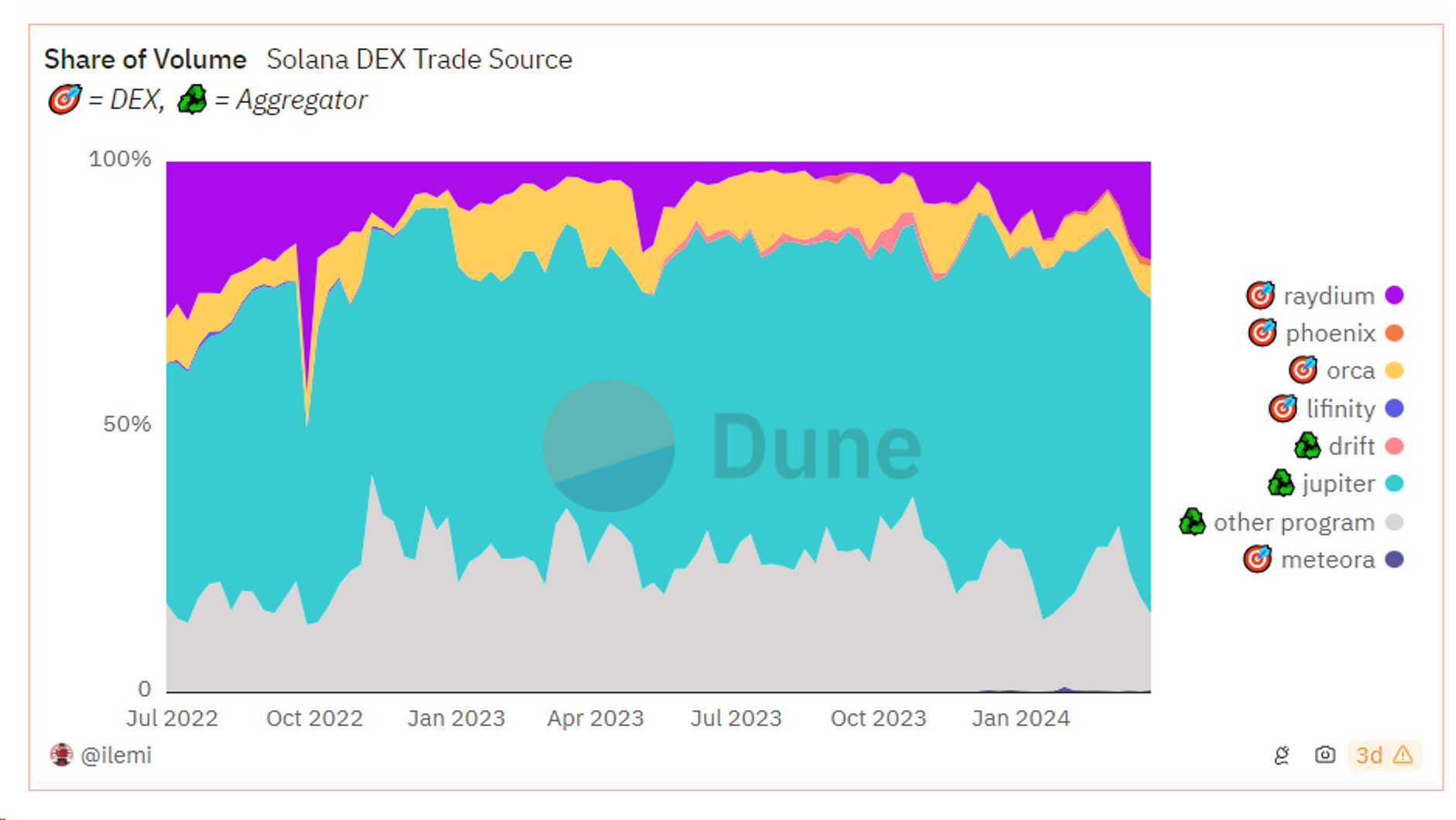
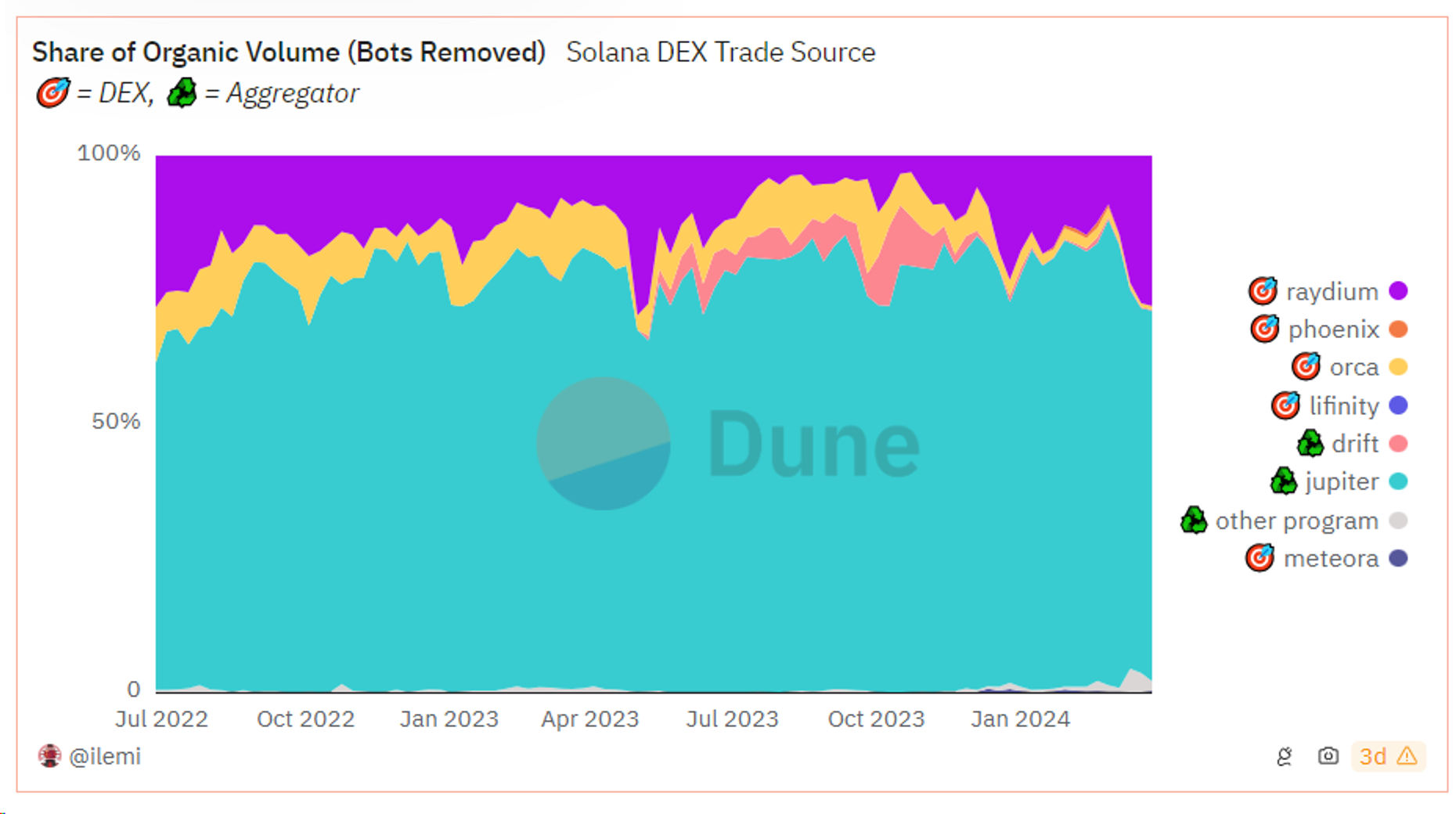
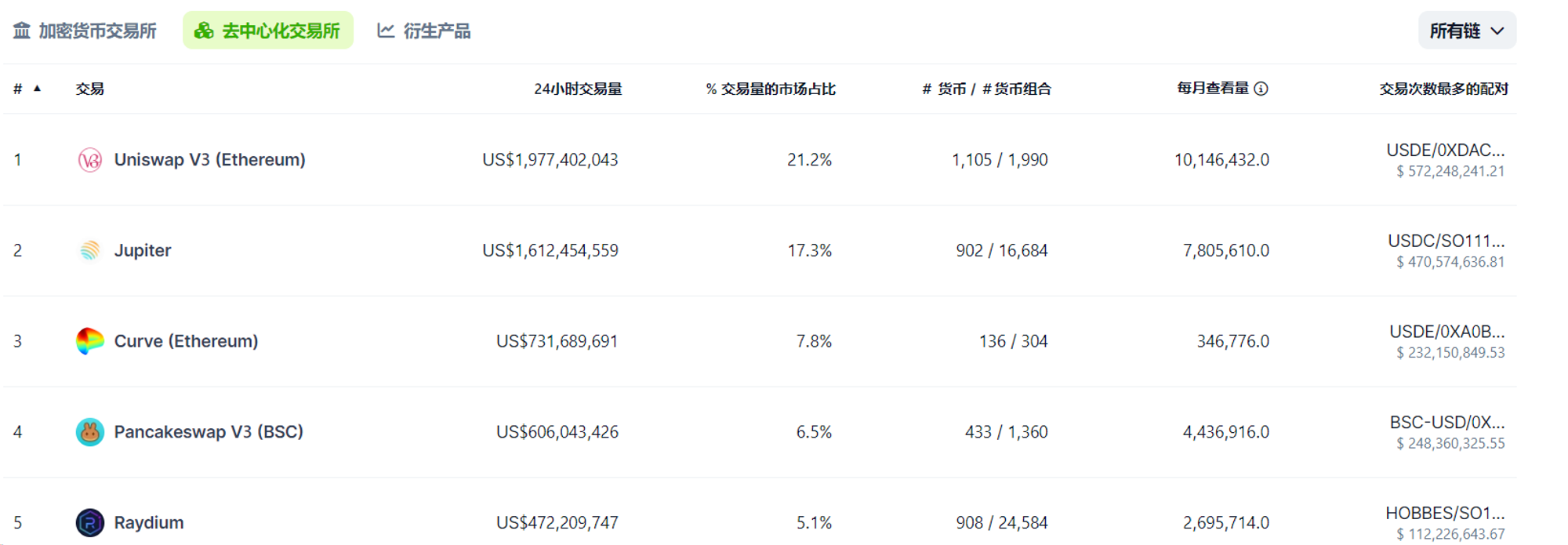
Next, Jupiter has launched Jupiter Start and Launchpad. With Jupiter's significant capture of users and traffic in the Solana ecosystem, it is foreseeable that future projects in the Solana ecosystem will have a high level of integration with Jupiter, whether through the Jupiter Launchpad or direct airdrops to JUP holders. Jupiter will greatly benefit from the birth and growth of new projects in the Solana ecosystem.
In terms of token performance at this stage, the price growth of Jupiter and Solana is basically synchronized. In the past month, the increase in JUP has exceeded SOL, indicating that JUP will become a leveraged target for SOL.
2 Fundamental Analysis: Top DEX Aggregator on Solana
Jupiter was launched in November 2021 and its product can be divided into two parts: trading infrastructure and LFG Launchpad. The trading infrastructure includes liquidity aggregation, limit orders, DCA (Dollar Cost Averaging), and Perps trading. This section will provide a brief introduction to Jupiter's products.
2.1 Liquidity Aggregation
Token prices change rapidly, and the best price for a trade is not always on a single DEX, but may involve a combination of trades across multiple DEXs. As a liquidity aggregator, Jupiter finds the most favorable price route among all major DEXs and AMMs on Solana, minimizing slippage and transaction costs, making the trading process more efficient and user-friendly. The aggregator's operation mainly consists of two methods: Multi-hop routing and order splitting. Multi-hop involves using an intermediary token C (A-C-B) to achieve a better exchange from token A to token B, while order splitting involves splitting a trade into multiple parts and completing them on different DEXs.
Currently, Jupiter uses a routing algorithm called Metis, designed to provide the best price route within Solana's fast block time. Compared to V1 and V2, Metis offers more flexible and complex trading paths, resulting in better price discovery. Additionally, the Metis algorithm supports a greater number of DEXs and demonstrates stronger quoting capabilities in large trades. According to official Jupiter data, the quoting capability of Metis is on average 5.22% higher than the V2 engine, and the improvement increases rapidly with the trade amount.
Currently, Jupiter's aggregator does not charge users. It primarily serves as the front end for user trades, attracting attention and traffic within the Solana ecosystem, making it well-suited for conducting Launchpad business. However, it is important to note that during the previous Solana MEME craze, Jupiter's position as a trading front end was impacted by trading bots. On one hand, trading bots have a more user-friendly operation and are equipped with sniper, token information query, and other functions, naturally tailored for MEME tokens. On the other hand, Jupiter's token update speed cannot meet the requirements for rapid listing of MEME tokens, and the token pairs will only be displayed on Jupiter after meeting certain liquidity requirements.
2.2 Limit Orders
Jupiter provides users with the ability to place limit orders, giving them a trading experience similar to CEX, avoiding slippage and MEV issues caused by rapid price changes on-chain. Similar to other on-chain limit order platforms, Jupiter's limit orders are not an order book system, but are monitored by Keepers using the Jupiter Price API to execute trades when the price reaches specified criteria. Benefiting from Jupiter's liquidity aggregation, limit orders can also utilize multiple liquidity pools on Solana to complete trades.
Currently, Jupiter supports trading between any token pairs, providing a more convenient trading experience than CEX. Additionally, Jupiter has partnered with Birdeye and TradingView, with Birdeye providing on-chain price data and TradingView integrated into the front end to provide users with more convenient chart data display. Jupiter currently charges a 0.1% platform fee.
2.3 DCA (Dollar Cost Averaging)
Jupiter DCA (Dollar Cost Averaging) is a systematic investment plan that allows users to automatically buy or sell any token in the Solana ecosystem at regular intervals. Jupiter DCA charges a 0.1% platform fee, which is collected with each trade execution. DCA is an important strategy for both buying and selling, as accumulating chips through systematic investment can mitigate sharp price fluctuations and achieve a more stable and average cost over a period of time. DCA is also suitable for selling strategies during a bull market. Additionally, for large trades or tokens with poor liquidity, continuous chip absorption over a period of time can help mitigate price impact.
2.4 Perps Trading
Perps trading operates based on LP providing liquidity and Pyth oracle providing price data, and is currently in the beta testing phase. The operation mechanism of Perps trading is similar to the GLP pool mode of GMX. LPs provide liquidity to the JLP pool, and contract traders collateralize various Solana assets, choose leverage multiples from 1.1x to 100x, borrow relevant liquidity from the JLP pool (for example, for long positions on SOL, the trader needs to borrow the corresponding amount of SOL based on the leverage multiple, and for short positions on SOL, stablecoins need to be borrowed), and after closing the position, the trader receives profits/covers losses, and returns the remaining tokens to the JLP pool. For long positions on SOL, if the trader profits, the number of SOL held by the JLP pool decreases, and the trader's profit comes from the JLP pool.
Currently, the JLP pool supports five assets: SOL, ETH, WBTC, USDC, USDT. The JLP pool will receive 70% of the exchange's revenue, including trading fees for opening and closing positions, as well as interest fees for borrowing (the related fee schedule is shown in the table below). Currently, the TVL of the JLP pool is $331,384,506.56, with the corresponding asset proportions shown in the following figure.
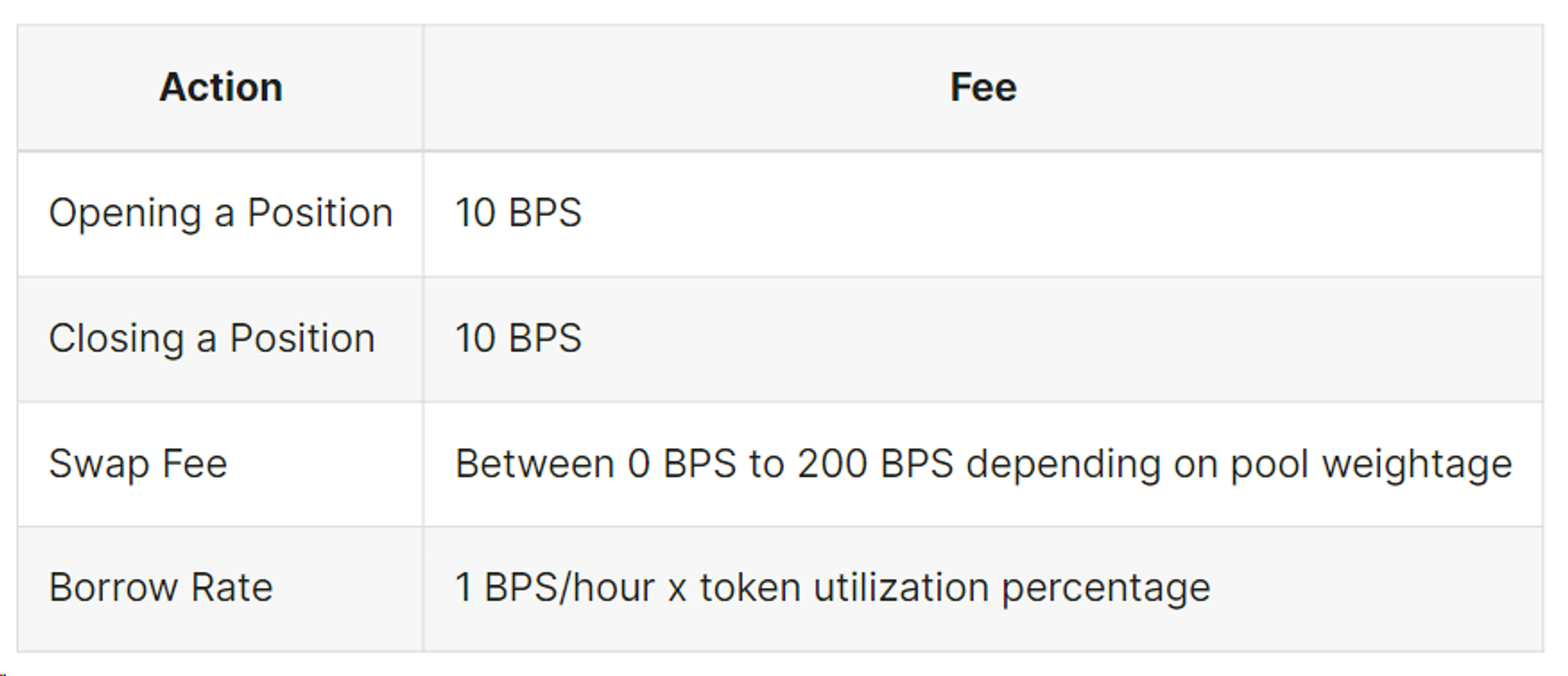
2.5 LFG Launchpad
Jupiter launched the beta version of Launchpad in January 2024 and has completed the token issuance for JUP, WEN, and ZEUS. The participants in the Launchpad mainly consist of three parties: the project team, the JUP community, and token buyers.
For the project team, Jupiter is the largest traffic entry point on Solana. Choosing Jupiter as the launchpad will greatly capture Solana ecosystem users. Additionally, projects participating in the Launchpad need to provide a certain amount of tokens (generally 1% of the tokens) to incentivize the JUP community and the team.
The JUP community consists of voters who own and stake JUP. They vote to decide the next project to be launched on Jupiter and receive corresponding rewards. In terms of voting rules, users lock a certain amount of JUP to obtain the corresponding voting power. There is no minimum token requirement for voting, but each wallet can only vote for one project. Token unlocking requires 30 days, and during the unlocking countdown, users can still vote, but their voting power will decrease accordingly. After the voting, the two projects currently scheduled to be launched on Jupiter are Zeus Network and Sharky. For JUP holders, the benefits of staking and voting include:
- Launchpad project airdrops: For example, Zeus Network announced an airdrop to 181,889 addresses that participated in voting on Jupiter LFG Launchpad. Airdropping tokens to voters is a common practice to attract JUP voters.
- Jupiter governance rewards: 100 million JUP and 75% of the Launchpad fees will be used for governance incentives, with rewards distributed quarterly. This quarter's rewards will be 50 million JUP and the Launchpad fees for this quarter, with the remaining 50 million JUP to be distributed as rewards in the next quarter. The Launchpad fees are 0.75% of the total token supply paid by the project to the JUP DAO.
For token buyers, the JUP Launchpad uses the Dynamic Liquidity Market Maker (DLMM) model for token sales. The DLMM model divides a price range into multiple discrete price intervals, with the team mainly providing token liquidity and users providing USDC liquidity to complete the token sale. Additionally, to minimize the impact of complex mechanisms on users, Jupiter still provides DCA and limit order functions, allowing users to complete token purchases with appropriate strategies during the token sale.
The first unofficial project on Jupiter Launchpad, Zeus Network, is currently in progress. The launch price range for ZEUS on the Launchpad is $0.3-$0.85, with a peak price of $1.11, and the current price is $0.83 (data as of April 11). At this price, the total airdrop value received by JUP voters is $8,300,000 (1% of ZEUS). Additionally, for the issued JUP and WEN tokens, the majority of participants have received returns of more than 3 times:


2.6 Summary
Based on the above analysis, we believe that Jupiter's advantages in its products are as follows:
- Jupiter provides a complete set of trading tools, creating an excellent user trading experience: From basic spot and Perps trading to DCA and limit orders, it provides almost all necessary basic functions for users. Additionally, benefiting from liquidity aggregation, DCA and limit orders also connect to a wider range of liquidity.
- The development direction from trading infrastructure to Launchpad is reasonable: The trading infrastructure captures a large number of users, making Jupiter the center of traffic on Solana, which naturally meets the needs of the Launchpad. The various trading functions also lower the barriers for users to participate in token sales. The Launchpad's functionality deepens Jupiter's integration with the Solana ecosystem, strengthens Jupiter's infrastructure and leadership position, and enhances the token empowerment of JUP.
3 Token Economics and Fund Analysis
3.1 Token Economics Analysis
Jupiter's total supply is 10 billion, and the token distribution is as follows: The Jupiter team will manage 50% of the tokens, and the remaining 50% will be allocated to the community.
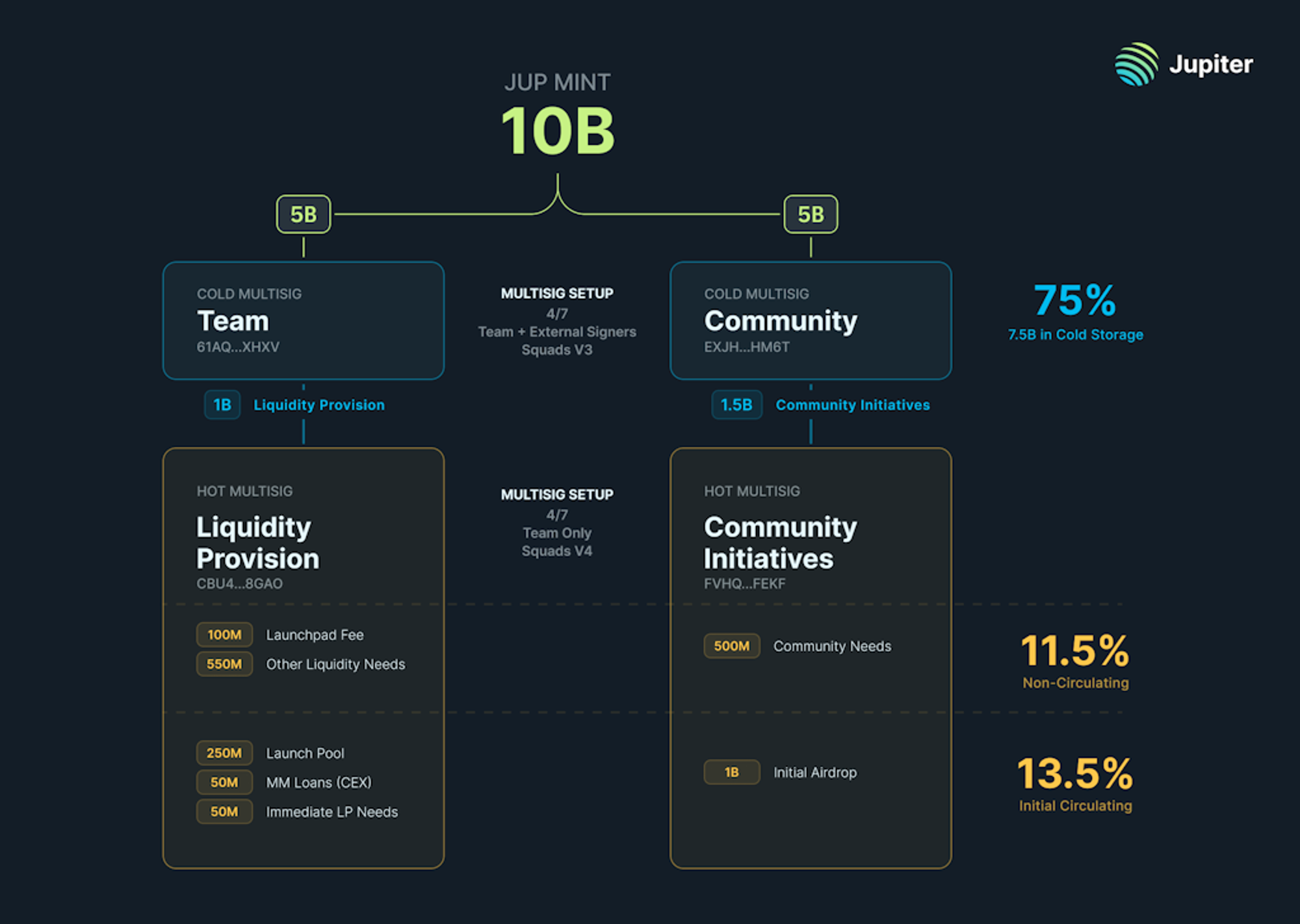
Among the 50% of tokens belonging to the team, 20% will be allocated to team members, but distribution will begin two years later. 20% will go into the strategic reserve, stored in the 4/7 Team Cold Multisig wallet, and these tokens will be locked for at least one year. The community must be notified at least six months in advance of any liquidity event. The remaining 10% of JUP tokens will be used for liquidity supply and stored in the Team Hot Multisig wallet.
Of the 50% of tokens belonging to the community, 40% will be distributed through four separate airdrops, which will take place on January 31 each year. The remaining 10% of tokens will be provided as grants to community contributors.
In the Genesis issuance, a total of 1.35 billion (13.5%) tokens entered circulation, including 10% for separate airdrops (1 billion), 250 million tokens allocated to the Launchpad, 50 million for the market maker's loan, and 50 million for liquidity provision.
Therefore, according to the token supply plan, there will be no large-scale unlocking of JUP before 2025. The 50% of tokens belonging to the team will not unlock in the next year, and any unlocking will be notified to the community at least six months in advance. The next major unlocking will come from the 1 billion airdrop on January 30, 2025.
In terms of token empowerment, the current main use is staking and voting to receive governance incentives and Launchpad project airdrops. As of April 4, 2024, a total of 269,290,321 JUP tokens are staked, accounting for approximately 20% of the current circulation. However, it is worth noting that Jupiter's founder Meow stated in a Reddit AMA that the purpose of JUP token design is not for utility, and believes that the price growth of JUP will come from value rather than actual utility.
3.2 Fund Analysis
The market value of JUP is $2,101,677,968, and the FDV is $15,567,984,945 (data as of April 11). Since there will be no large-scale unlocking in the next year, the market value is more indicative than the FDV.
JUP's trading is mainly concentrated on Binance, followed by OKX, Bybit, and Gate. According to the trading data on Binance, JUP maintained a relatively long time around the $0.5 price level and completed a large amount of turnover in the $0.5-$0.7 price range, which is the intensive cost range for JUP and has become a strong support. After stabilizing for 2 months, the price of JUP began to break through the bottom cost range and has now entered a new price range.
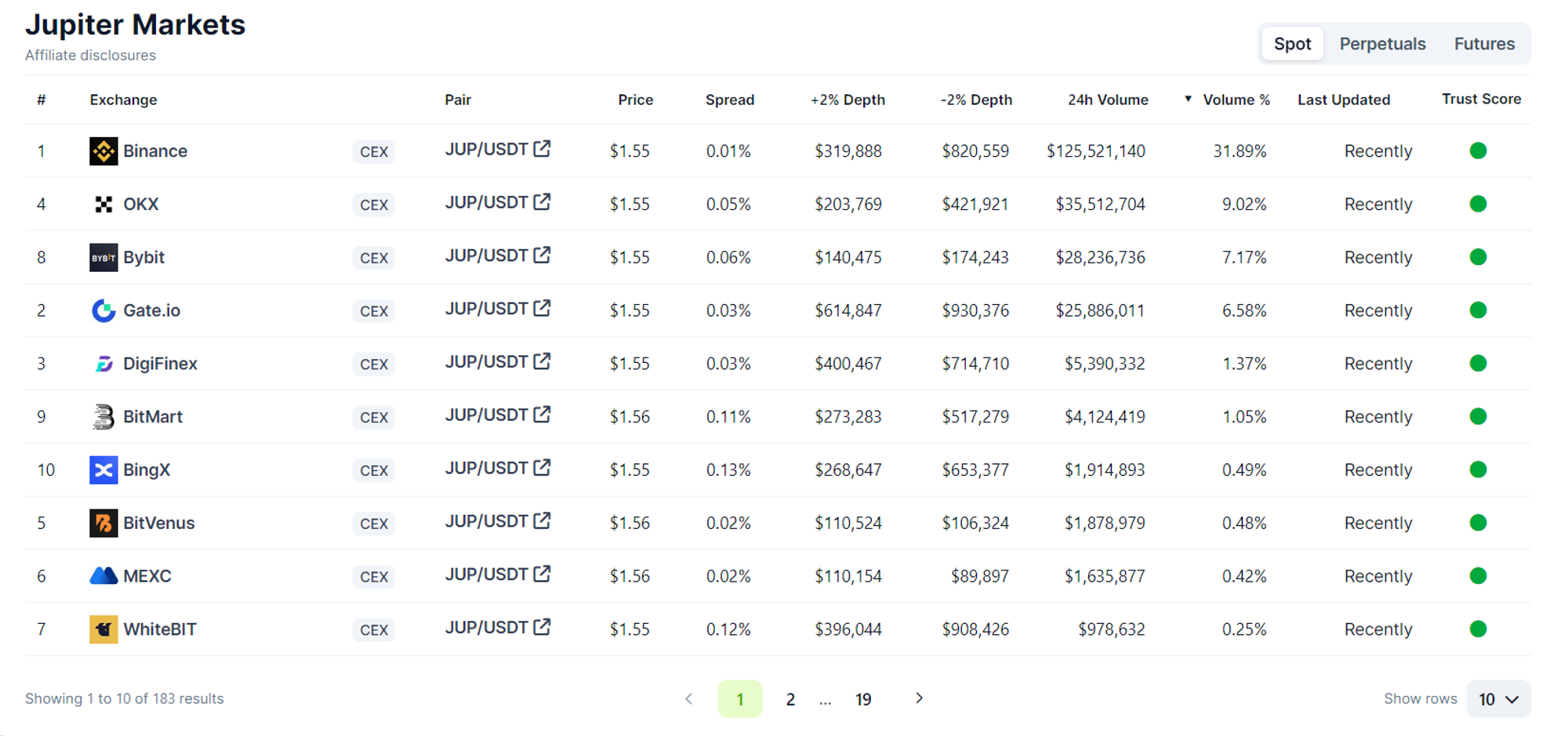
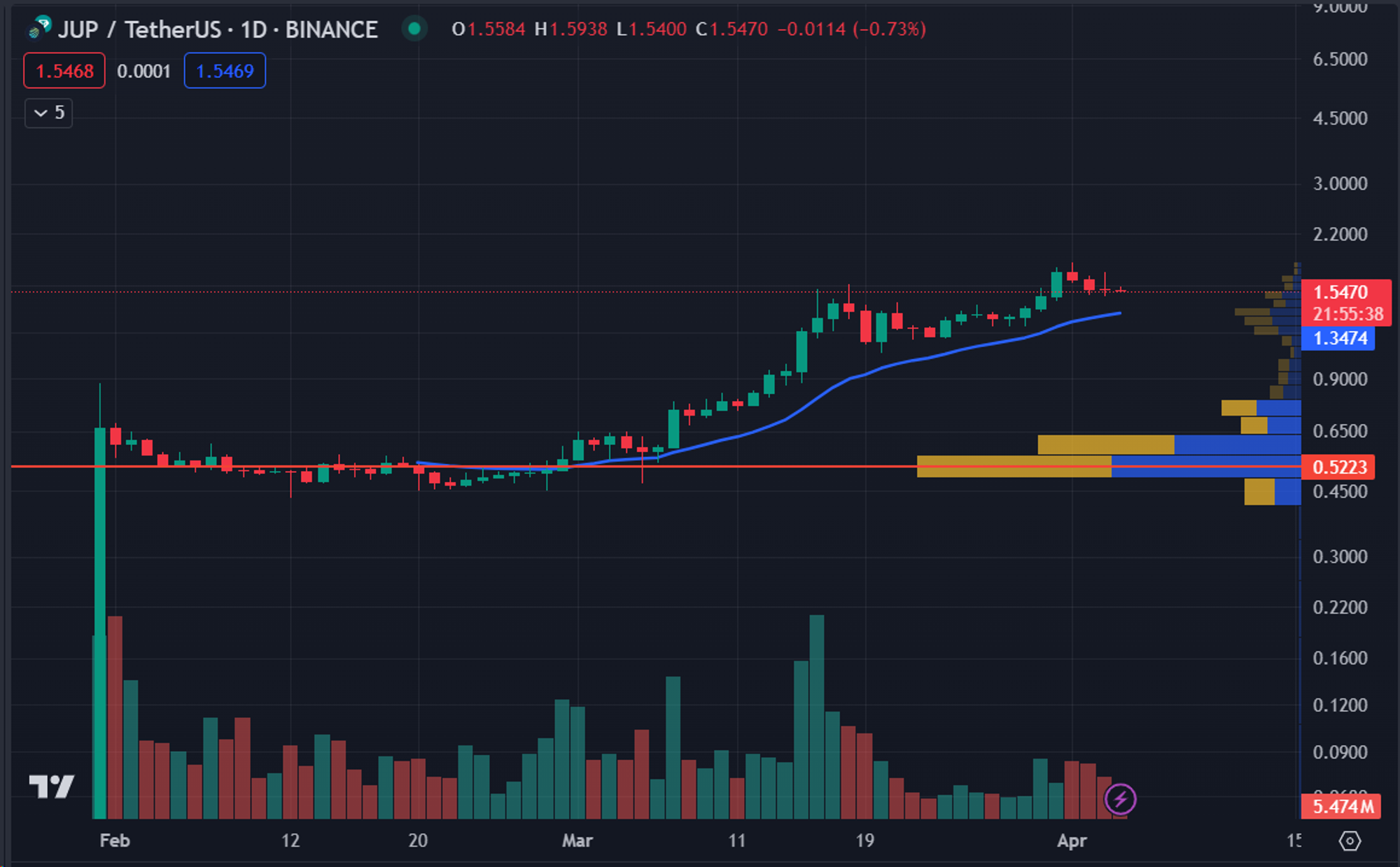
4 Competitor Analysis: Who is the Best Leveraged Investment in Solana?
As a trading aggregator, Jupiter holds a unique position in the Solana ecosystem. With its unique functionality and significant capture of trading volume, there is currently no trading protocol in the Solana ecosystem that directly competes with Jupiter. Therefore, the consideration is whether JUP is a good choice for a leveraged investment in the Solana ecosystem.
There are many choices for leveraging in the Solana ecosystem, including infrastructure (such as JUP), leading MEME tokens (such as WIF), and other ecosystem projects (such as AI and DePIN projects), but the returns vary for different categories. MEME tokens have greater uncertainty, while other ecosystem projects are more closely related to their own narratives (for example, RNDR will benefit from the growth of AI narratives, rather than the growth of the Solana ecosystem). Therefore, the projects that resonate most with Solana are the infrastructure protocols in the Solana ecosystem, such as trading infrastructure (Raydium/Orca/Jupiter), liquidity staking protocols (Jito), and oracles (Pyth). Compared to these projects, Jupiter's advantages mainly lie in:
- In terms of basic business, Jupiter captures more users and traffic in the Solana ecosystem. Among all businesses, the most basic requirement for users is trading, especially as the Solana ecosystem has recently focused on Memecoins, further emphasizing the importance of trading. With Jupiter's monopoly position in the Solana trading front end, users entering the Solana ecosystem will naturally become Jupiter users. Jupiter will become the first stop for users in the Solana ecosystem, with the strongest and most direct connection to the Solana ecosystem, and the strongest representation of the Solana ecosystem.
- In terms of new ecosystem airdrops, Jupiter's Launchpad functionality allows JUP holders to receive airdrop rewards from new projects, while Raydium/Orca and Jito have not shown strong competitiveness in this area. Similarly, projects that can capture potential airdrops include Pyth, as multiple projects have already provided airdrop rewards to Pyth stakers (such as Wormhole). It is necessary to continue monitoring the progress of Jupiter's Launchpad and the wealth effect of token sales. If Jupiter uses its traffic advantage to attract a large number of high-quality projects for launch, JUP holders will receive higher returns and capture the value of more new projects in the Solana ecosystem.
5 Conclusion
With its trading entry and Launchpad functionality, Jupiter is considered by many to be the Uniswap and golden shovel of the Solana ecosystem, and JUP is also seen as BNB. In summary, we believe that Jupiter's bullish advantages are:
- It has built a complete product matrix related to trading, greatly improving the user trading experience. Jupiter's trading volume has risen rapidly, making it the second largest trading infrastructure after Uniswap.
- Backed by the strong traffic and user base captured by Jupiter, the Launchpad established by Jupiter will capture more value from new projects in the Solana ecosystem and provide numerous airdrop rewards to JUP token stakers. The projects currently launched have all shown good price performance.
- In terms of funding, JUP tokens will not face large-scale unlocking and selling pressure in the next three quarters, and the chip structure is relatively stable. From a price performance perspective, JUP has moved out of the bottom cost range and entered a new growth space.
- With its close connection to the Solana ecosystem, Jupiter can be seen as a leveraged investment in Solana. In this cycle, Solana will be as important as Ethereum in terms of public chains and ecosystems. With Solana's market value reaching new highs, choosing JUP as an amplifier may be a better way to position for long-term growth in Solana.
Risks associated with Jupiter may include:
- The growth of the Solana ecosystem does not meet expectations.
- The development of a large number of trading bots or other trading front ends may challenge Jupiter's position as the first trading entry point.
- The lack of utility for Jupiter's token may hinder its price growth.
- The effectiveness of Jupiter's Launchpad (including the number, quality, and wealth effect of projects) does not meet expectations.
免责声明:本文章仅代表作者个人观点,不代表本平台的立场和观点。本文章仅供信息分享,不构成对任何人的任何投资建议。用户与作者之间的任何争议,与本平台无关。如网页中刊载的文章或图片涉及侵权,请提供相关的权利证明和身份证明发送邮件到support@aicoin.com,本平台相关工作人员将会进行核查。




